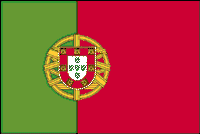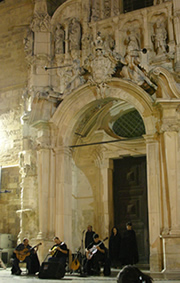


| Related Blog Postings: Cough, Cough... Obrigado, Portugal Historic Portugal Snapshorts of Portugal |
Photostitch in Action - The towns of Coimbra and Porto A Fado Experience - Unique Portugese
music |
 We
travelled with Jon in a whirlwind visit to Portugal, entering by train
from Madrid, leaving by bus to Seville just five days later. We spent
two days in Lisbon, then rented a car to visit the tourist town of Sintra,
the university town of Coimbra, and the old town of Porto, Portugal's
second largest city. We confused our newly learned Spanish with Portuguese,
ate bizarre dishes like tripe,
and learned a bit about what makes Portugal such a beautiful and unique
country.
We
travelled with Jon in a whirlwind visit to Portugal, entering by train
from Madrid, leaving by bus to Seville just five days later. We spent
two days in Lisbon, then rented a car to visit the tourist town of Sintra,
the university town of Coimbra, and the old town of Porto, Portugal's
second largest city. We confused our newly learned Spanish with Portuguese,
ate bizarre dishes like tripe,
and learned a bit about what makes Portugal such a beautiful and unique
country.

The city of Lisbon, on the Rio Tejo. A reasonably large city without the crowded feel. Downtown was incredibly quiet on Sunday, except for wandering tourists like us. |

The futuristic station at Estação do Oriente. Here, we made connections between the speedy (and still developing) metro, rental car, and international bus station. |

A cruising manta ray at the impressive Oceanário de Lisboa, which rivaled even Monterey Bay's Acquarium, in our opinions. Definitely worth the line-up to get in. |

Jen silhouetted in front of the massive central tank at the Lisbon Oceanarium. |

Winston calls up the Lisbon Mayor to espresses his extreme displeasure with the slow drink service at the Expo '98 site. |

Fountain of fancy: one of the many interesting discoveries at the Parque das Nações, the former Expo 98 site. |
 Jon and his big bowl of soup. We thought he looked great with his goatee (and possibly shaved head), but alas, he took it off a few days later! :( |

The outline of the Museu da Marinha at sunset, in Belem, Lisbon. |

Alvalade XXI Stadium, in Campo Grande. We watched some of the football season's opening night celebration on TV. Thanks to Rui for the correction! |

The ecclectic (and ridiculously crowded) Palácio da Pena in Sintra, a bizarre mix of domes, towers, ramparts and walkways. |

Jen framed by an archway at the Palácio da Pena. Inside is just as bizarre with most of the interior preserved from the royal family's flight from Portugal in 1910. |

A little plaza in the old town of Coimbra, where we had dinner under the stars. Coimbra has a deep academic tradition, centered in the country's oldest university, the Velha Universidade. |

Lots of jamon; we were a bit surprised by all the ham legs that were hanging around on the walls of cafes and restaurants. |

An example of the beautiful Portuguese azulejos, or tiles. Large azulejo panels, typically in blue and white, can be found throughout the country |

A beautiful treat: we stumbled upon an open concert of Coimbra fado (see more below). Dubbed "Portuguese blues," the melancholy music was haunting and mysterious. |
 The interior of the Biblioteca Joanina, an elaborately decorated Baroque library found at the University. Some of the books on the shelves apparently date back to the 16th century. |
 Sharing a toast; a little bit of port-tasting at the Ramos Pinto wine cellar. The region along the Duoro river is famous for its port wine production. It was excellent! |

We drove a speedy little Renault 206 to Porto and back from Lisbon. Average speed for us was about 140km/hr, but there were many cars that zoomed past us as if we were just going 40km/hr! |

In Porto, a local fisherman throws his line into the River Duoro. Along with the Vila Nova de Gaia across the river, Porto was one of the most scenic towns we had ever seen. |

Double images: a cheeky expression in the car window. |
 An abandoned boat in the Rio Duoro ("river of gold"), with the town of Gaia in the background. |
 Sunset in Porto. It took a lot of messing around with exposure and flash levels to finally get a decent sunset shot. |
 The Duoro River at night with the reflections of the neon Port cellar signs. |
 A store window in the old town of Porto. |
 We had a few of these confusing stop sign/green light combinations along the way. |

An ancient cemetary in Porto. |

A local Porto woman in animated conversation with a friend. |

A blind musician playing the accordian for coins |

Ancient Roman ruins at Conimbriga. Here you can see the remains of a Roman bathhouse |

We were amazed at how well preserved the mosaic tiles were at this site |

A close-up of one Roman mosaic, apparently dating back to the first century |

Forest fires devastated much of the Portugese countryside this summer in a record breaking heat wave. |

These flames were almost too close for comfort, right beside the highway |
 A replica of Rio's Cristo Rei towers over Lisbon |

The "25th of April" bridge over the Rio Tejo beside Lisbon looks amazingly like San Francisco's Golden Gate Bridge |

The old town of Porto across the Ria Duoro
Portugese fado is characterized for tourists as the equivalent of "Portugese blues." It is a lyical and sentimental music, and is thought to have origins in African slave songs. Apparently, Coimbra is one of two version of the fado. It is the more academic stran that reflects Coimbra's university traditions.
After dinner at a cafe in Coimbra, we were walking though the town when we heard the music being sung. We followed the mournful tunes to an open square where we discovered a late evening concert being held. Hundreds of visitors and locals were sitting in the plaza in front of Igreja de Santa Cruz listening to the simple but melancholy melodies of the fado.
The four-stringed cavaquinho and the bigger guitarra portuguesea
were being played in accompaniment to the singers. It was a magical way
to end our evening in this ancient city.
© 2003-2004 Winston & Jennifer Yeung. All Rights Reserved.


